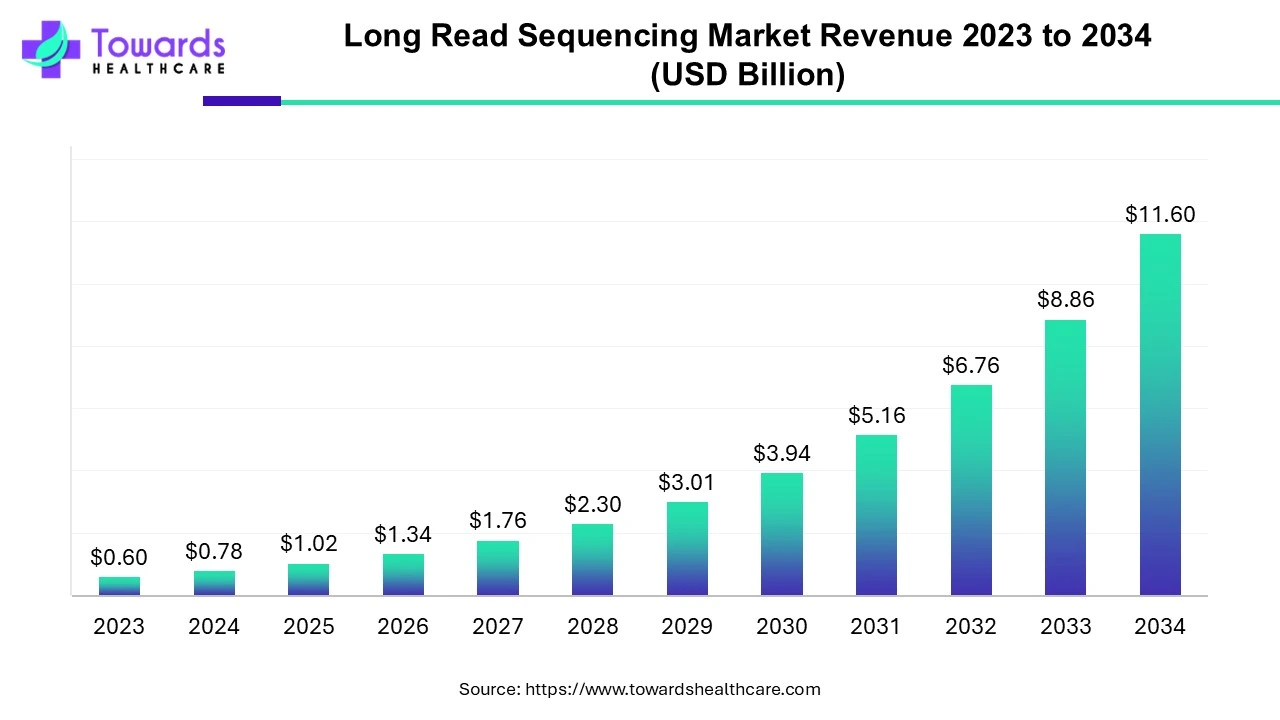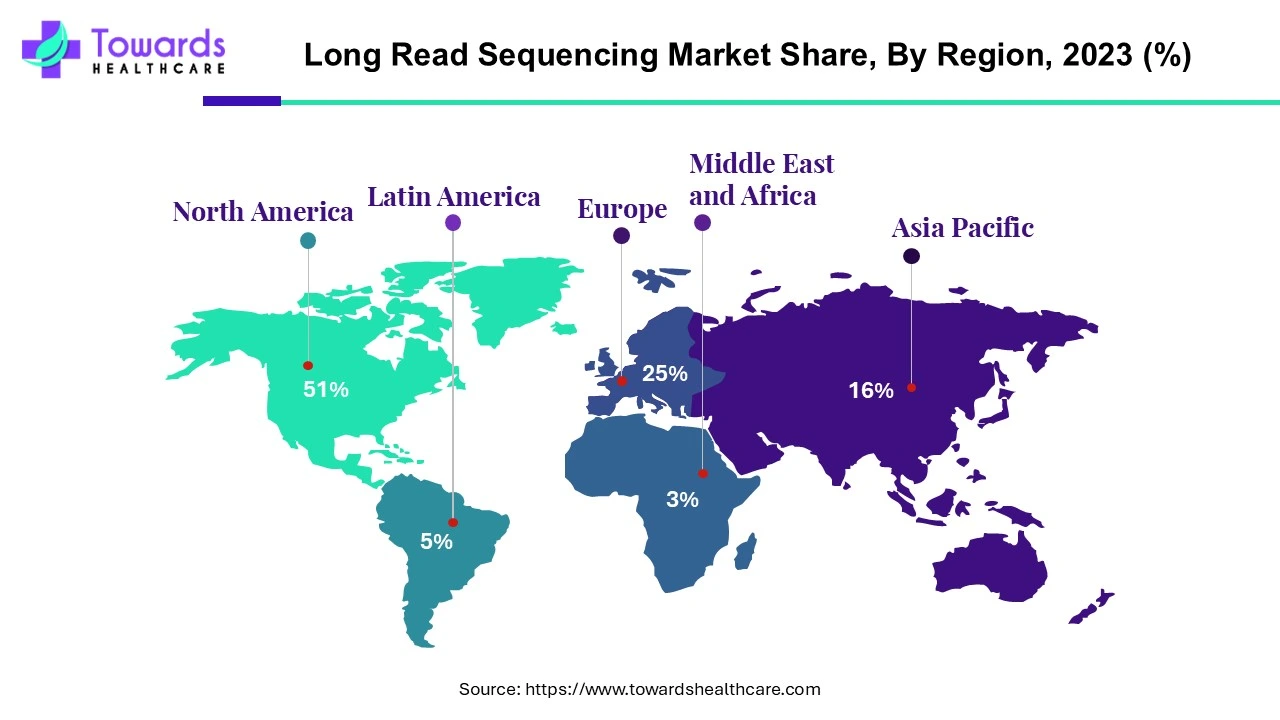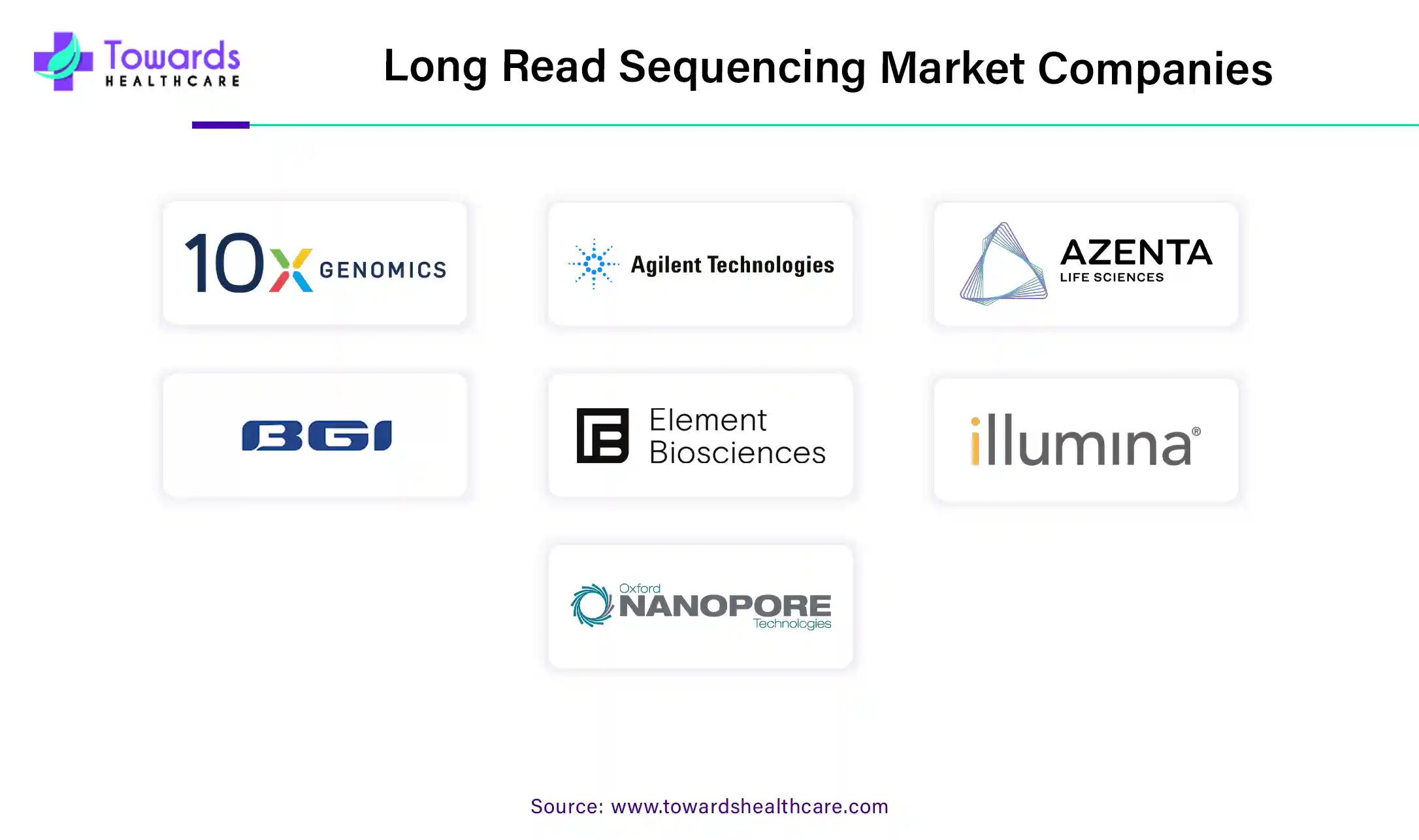March 2025


Principal Consultant

Reviewed By
The long read sequencing market was estimated at US$ 0.6 billion in 2023 and is projected to grow to US$ 11.6 billion by 2034, rising at a compound annual growth rate (CAGR) of 30.96% from 2024 to 2034. The rising incidences of genetic disorders, growing research and development, and increasing demand for personalized medicines drive the market.

Long-read sequencing (LRS) is one of the techniques of DNA sequencing in which the nucleotide sequence of long strands of DNA is determined. It is more favorable than short-read sequencing as it eliminates the need to cut up and then amplify the DNA. It can generate reads tens to thousands of kilobases in length with greater accuracy. These techniques implement different methodologies but are capable of sequencing long lengths of DNA. Long-read sequencing can more accurately detect large-scale mutations, where long sections of DNA are deleted or moved.
The increasing demand for genomics research due to rising incidences of genetic and chromosomal disorders boosts the market. In addition, the study of genetic variation and the discovery of mutations underlying human disease are dependent on technological advancements in molecular biology. The rising need for personalized medicines also potentiates LRS technology.
Personalized or precision medicines are therapeutics that are tailored based on an individual’s clinical and genetic requirements. The rapidly changing demographics are one of the reasons for using personalized medicines. Genomic testing aids in identifying the risk of developing a disease later in life and taking early actions to help prevent or reduce its likelihood. LRS is used to detect and diagnose rare genetic disorders within the population. Apart from genetic disorders, long-read sequencing is also used to detect tumors and infectious diseases. It has also emerged as a valuable tool in the field of transplantation, particularly in understanding the complex interplay between donor and recipient immune systems. Hence, the technology opened the door for additional advancements and enhancements that may eventually result in clinical practice using personalized medicines.
The major challenge of the market is the low accuracy of LRS. The LRS technique is less accurate than short-read sequencing. Another major challenge is the high cost per base compared to short-read sequencing. The average cost of LRS is several thousand dollars. This limits the affordability of several researchers from low- and middle-income countries.

North America held the largest share of the long read sequencing market in 2023. The state-of-the-art research & development facilities, increasing investments & collaborations, and the presence of key players drive the market. The key players, such as PacBio, Azenta, Thermo Fisher Scientific, and Illumina, hold a major share of the global market. Novel drug discovery research and increasing awareness of personalized medicines boost the market. The market is also driven by favorable government policies and regulatory approvals for personalized medicines. In 2022, the US FDA approved 12 novel personalized medicines, accounting for 34% of all newly approved therapeutics. Out of which, 5 were new cell and gene therapies.
Asia-Pacific is projected to host the fastest-growing long read sequencing market in the coming years. The rising geriatric population, increasing genetic and chromosomal disorders, and growing research and development drive the market. The market is also driven by favorable government policies to support genomics in respective nations. As of January 2024, whole genome sequencing of 10,074 individuals across 99 communities was completed under the ‘GenomeIndia Project.’ China's government also actively supports genomic research. In 2016, it announced a $9 billion, 15-year project to collect, analyze, and sequence genomic data to become a global leader in precision medicine. Similarly, the Japanese government supports the advancement of genomic research and the strengthening of collaboration with international research communities.
By product, the consumables segment dominated the long read sequencing market in 2023. Consumables for LRS include flow cells, assay kits, and reagents. They can eliminate the need to buy the entire sequencing kit.
Tthe services segment is expected to grow at the fastest rate in the market during the forecast period. The availability of a lack of trained professionals and favorable infrastructure in small research institutions demands LRS services. In addition, the services can save a lot of time for researchers, allowing them to focus on outcomes rather than the procedure.
By technology, the nanopore sequencing segment accounted for a considerable share of the long read sequencing market in 2023. Nanopore sequencing is the only sequencing technology that enables real-time analysis in fully scalable formats, analyzes native DNA or RNA, and provides real-time analysis. In addition, it is proven with a variety of input materials such as genomic DNA, amplified DNA, cDNA, and native RNA.
The single molecule real-time sequencing segment is predicted to witness significant growth in the market over the forecast period. Single-molecule real-time (SMRT) sequencing minimizes chemical modifications during library preparation, eliminating the need for DNA amplification. It also allows for the detection of various types of epigenetic modifications.
By workflow, the sequencing segment led the global long read sequencing market in 2023. Sequencing is one of the essential steps for LRS. Nucleotides are read on a sequencer at a read length and depth, and the clonal clusters are detected one base at a time.
The data analysis segment is anticipated to grow with the highest CAGR in the market during the studied years. Data analysis is the final step of the workflow. It involves analyzing the sequence reads produced by the sequencer. It involves two steps: read processing and sequence analysis.
By application, the whole genome sequencing segment registered its dominance over the global long read sequencing market in 2023. The rising demand for personalized medicines, identifying causative variants, and novel genome assembly boost the segment growth.
The metagenomics segment is projected to expand rapidly in the market in the coming years. The rising incidences of chronic disorders, disease prognosis research, and novel drug discovery augment the segment growth.
By end-use, the academic & research institutes segment dominated the long read sequencing market globally in 2023. The growing research and development in research institutions and the increasing number of publications & patents promote segment growth.
The pharmaceutical & biotechnology companies segment is anticipated to grow fastest in the market during the forecast period. Companies that have favorable infrastructure, sufficient funding, and research facilities augment segment growth.

In January 2024, PacBio CEO Christian Henry announced that it more than doubled its fourth-quarter sales of $58.4 million, i.e., a 113% increase compared to $27.4 million collected in the last three months of 2022. This surge in revenue was attributed to the recently launched two major DNA sequencing machines. He also said that he expects to see long-read DNA sequencing take as much as half of the market within the next five years.
By Product
By Technology
By Workflow
By Application
By End-Use
By Region
March 2025
December 2024
November 2024
November 2024